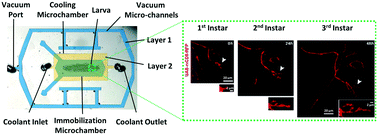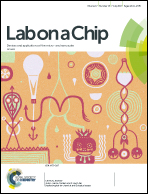On chip cryo-anesthesia of Drosophila larvae for high resolution in vivo imaging applications†
Abstract
We present a microfluidic chip for immobilizing Drosophila melanogaster larvae for high resolution in vivo imaging. The chip creates a low-temperature micro-environment that anaesthetizes and immobilizes the larva in under 3 minutes. We characterized the temperature distribution within the chip and analyzed the resulting larval body movement using high resolution fluorescence imaging. Our results indicate that the proposed method minimizes submicron movements of internal organs and tissue without affecting the larva physiology. It can be used to continuously immobilize larvae for short periods of time (minutes) or for longer periods (several hours) if used intermittently. The same chip can be used to accommodate and immobilize arvae across all developmental stages (1st instar to late 3rd instar), and loading larvae onto the chip does not require any specialized skills. To demonstrate the usability of the chip, we observed mitochondrial trafficking in neurons from the cell bodies to the axon terminals along with mitochondrial fusion and neuro-synaptic growth through time in intact larvae. Besides studying sub-cellular processes and cellular development, we envision the use of on chip cryo-anesthesia in a wide variety of biological in vivo imaging applications, including observing organ development of the salivary glands, fat bodies and body-wall muscles.



 Please wait while we load your content...
Please wait while we load your content...